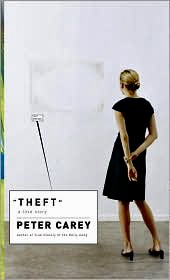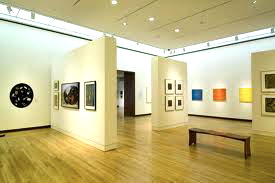Note: Peter Carey is a two-time WINNER of the Booker Prize.
“Artists are used to humiliation. We start with it and we are always ready to return to real failure, the bottom of the barrel, the destruction of our talent by alcohol or misery. We live with the knowledge that, alongside Cezanne or Picasso, we are no-one, were always no-one, will be forgotten before we are in the ground. Shame, doubt, self-loathing, all this we eat for breakfast every day.”
Peter Carey, one of Aus tralia’s most honored contemporary writers, creates his most dazzling novel yet with this send-up of the art world, filled with satire about dealers, auction houses, compulsive collectors, forgers, conservators and technicians, art researchers, catalogue writers, those who crate and ship paintings, and even the artists themselves. At the same time, he creates two splendid characters through whose limited vision this world is viewed—Michael “Butcher” Boone, a successful avant-garde artist from Australia, now experiencing hard times, and his “slow” brother Hugh, a 220-pound giant with little control over his emotions and a penchant for breaking the little fingers of people who get in his way.
tralia’s most honored contemporary writers, creates his most dazzling novel yet with this send-up of the art world, filled with satire about dealers, auction houses, compulsive collectors, forgers, conservators and technicians, art researchers, catalogue writers, those who crate and ship paintings, and even the artists themselves. At the same time, he creates two splendid characters through whose limited vision this world is viewed—Michael “Butcher” Boone, a successful avant-garde artist from Australia, now experiencing hard times, and his “slow” brother Hugh, a 220-pound giant with little control over his emotions and a penchant for breaking the little fingers of people who get in his way.
Butcher, who lost his best paintings when they were declared “marital assets” during a particularly nasty divorce, has just been released from jail after trying to steal them back, and he is now living in the “boonies” of northern New South Wales, as caretaker for the property of his biggest collector, Jean-Paul Milan. Jean-Paul has given him a place to stay and studio space so he can create new masterpieces (from which he expects a cut). But Butcher is not living alone. He has also become the full-time caretaker of his brother, “Hugh the Poet and Hugh the Murderer, Hugh the Idiot Savant,” and life is not easy for either of them. “Sometimes [Hugh] was so bloody smart, so coherent, at other times a wailing gibbering fool. Sometimes he adored me, loudly, passionately, like a whiskery bad-breathed child. But the next day or next minute I would be the Leader of the Opposition and he would lay in wait amongst the wild lantana, pounce, wrestle me violently into the mud, or the river, or across the engorged wet-season zucchini.”

Six months after their arrival in New South Wales, when floods accompany the rainy season and travel is especially difficult, Butcher rescues Marlene Leibovitz from her partially submerged car, a “chance” meeting that may not be so chancy. Marlene is the wife of Olivier Leibovitz, the only son of Jacques Leibovitz, a world-class artist whose paintings would be priceless, were it not for the fact that the art market always has a price, however stratospheric–and a buyer, individual or corporate. Marlene has come to this remote area to inspect a “Leibovitz” painting owned by the mysterious Dozy Boylan, Butcher’s next-door neighbor. As the wife of Leibovitz’s son Olivier, Marlene shares with him the “droit moral,” the sole right to authenticate Leibovitz paintings. Some years ago, Leibovitz’s now-deceased wife Dominique and her lover stole fifty finished, unfinished, and abandoned paintings in the hours before the police were informed of Leibovitz’s death, and the person with the droit moral (in this case, Marlene, through Olivier) controls the Liebovitz market by authenticating the undocumented paintings as they surface.
 The story of how Butcher is drawn into a complex scheme to defraud is told in alternating chapters by Butcher himself and by Hugh, who sees himself as his brother’s “helper,” not “manservant,” though he often inveighs against Butcher and his attitudes. Hugh is earthy—he sees Van Gogh as “mad as a toilet brush”—and his “take” on the characters and action lead to hilarious commentary. Butcher, never able to escape the responsibility for Hugh, is also trying to recover his reputation by creating a new set of masterpieces, and he is soon preparing for a show Marlene has set up for him in Tokyo—if he can figure out how to find a caretaker for Hugh. Totally devoted to his artwork, and eventually to Marlene, Butcher is a brawling innocent, completely over his head as he begins to move in international art circles in Tokyo and New York.
The story of how Butcher is drawn into a complex scheme to defraud is told in alternating chapters by Butcher himself and by Hugh, who sees himself as his brother’s “helper,” not “manservant,” though he often inveighs against Butcher and his attitudes. Hugh is earthy—he sees Van Gogh as “mad as a toilet brush”—and his “take” on the characters and action lead to hilarious commentary. Butcher, never able to escape the responsibility for Hugh, is also trying to recover his reputation by creating a new set of masterpieces, and he is soon preparing for a show Marlene has set up for him in Tokyo—if he can figure out how to find a caretaker for Hugh. Totally devoted to his artwork, and eventually to Marlene, Butcher is a brawling innocent, completely over his head as he begins to move in international art circles in Tokyo and New York.
The action ratchets up as the financial stakes in the art market increase, and a murder, filled with shocking details, draws the complexity of the art fraud into the open for the reader—and for Butcher. The final chapter, almost an Afterword, gives new meaning to the word “irony.” Theft is brilliantly constructed, and in Butcher and Hugh, Carey creates two narrators the reader cannot help but care about. No aspect of the art world and the rarified atmosphere of its collectors escapes Carey’s rapier wit, and the humor is non-stop. Well known for his word play and sense of the absurd throughout his novels, Carey has outdone himself with this novel, one of his best–a comic masterpiece. (On my Favorites List for 2006)
ALSO by Peter Carey: THE CHEMISTRY OF TEARS, A LONG WAY FROM HOME
Notes: The author’s photo appears on http://www.thechronicle.com.au
The art gallery image is from http://www.topboxdesign.com
